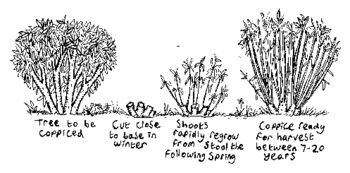Coppicing
|
|
Coppice_stool.jpg
by which young tree stems are cut down to a low level, or sometimes right down to the ground. In subsequent growth years, many new shoots will grow up, and after a number of years the cycle begins again and the coppiced tree or stool is ready to be harvested again. Typically a coppice woodland is harvested in sections, on a rotation. In this way each year a crop is available. This also has the side-effect of providing a rich variety of habitats, as the woodland always has a range of different aged stools growing in it. This is beneficial for biodiversity.
The cycle length depends upon the species cut, the local custom, and the use to which the product is put. Birch can be coppiced for faggots on a 3 or 4 year cycle, whereas oak can be coppiced over a 50-year cycle for poles or firewood.
These shoots (or "suckers") may be used either in their young state for interweaving in wattle fencing as is the practice with willows, or the new shoots may be allowed to grow and mature into large poles, as was often the custom with hardwood such as oaks or ashes. This practive creates long, straight poles which are better for working than naturally grown trees which have bends and forks. In Europe coppiced hardwoods were extensively used in shipbuilding (wooden ships) or carriagebuilding, and are now still grown, albeit in very small amounts, for making wooden buildings and furniture.
Coppicing may also be practiced to encourage specific growth patterns, as with cinnamon trees which are grown for their bark.

